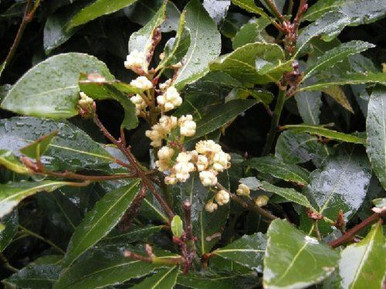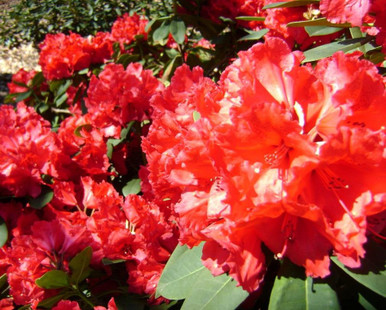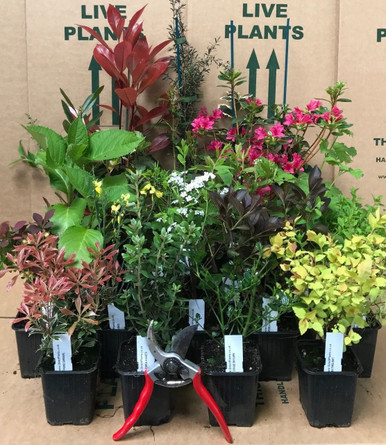At a Glance
- Variety:Cotinus
- Size:5-7 Litre pot
- Mature Height(?):
What does this mean?
Mature Height
You can expect the height to reach somewhere within this estimate. It is given as a guide but can vary dependant on several factors such as soil quality and position.
For Conifers and Trees this may be the height in 10-20 years, eventually the plant may exceed this height.
1.0-1.5m
- Mature Spread(?):
What does this mean?
Mature Spread
You can expect the plant to spread somewhere within this range estimate. It is given as a guide but can vary dependant on several factors such as soil quality and position.
For Conifers and Trees this may be the spread in 10-20 years, eventually the plant may exceed this.
1.0-1.5m
- Flower Colour(?):
What does this mean?
Flower Colour
Flowers come in a vast variety of colours from pure white to almost black. Colour can be affected by a number of factors including environment and diet. Use the photographs as a guide and expect variations.
white
- Flowering Time(?):
What does this mean?
Flowering Time
A plants development is synchronised with the changing seasons and flowering is one of several changes that occur at the appropriate time of year dependent on the specific plant. While our meteorological seasons are defined by specific dates; there can be two or the weeks difference in the start and end of the horticultural ‘season’ between the north and south of the UK.
Summer
- Foliage(?):
What does this mean?
Evergreen
Plants that have leaves all year round are classified as evergreen. They can however lose leaves sporadically throughout the year.
Deciduous
Deciduous plants drop their leaves in autumn, look bare in winter and put out new leaves again in spring. Some plants such a Beech retain their dead leaves until the new spring growth.
Semi-evergreen
There are exceptions, some plant drop their leaves in cold winters but keep them if it is mild. These are classified as Semi-evergreen.
Deciduous
- Fragrant(?):
What does this mean?
Fragrant
For plants that are fragrant the level of fragrance may vary, results may improve by planting in larger blocks. The fragrance may come from flowers or foliage.
No
- Growth Rate(?):
What does this mean?
Growth rate of a plant will determine how fast the plant reaches it ultimate height and is affected by four main factors: temperature, nutrients, light, and water.
Average
- Hardiness(?):
What does this mean?
Fully Hardy
Hardy in most places throughout the UK even in severe winters (to -15)
Half Hardy
Hardy throughout most of the UK (to -10)
Frost Hardy
Hardy in coastal and relatively mild parts of UK (to -5)
Fully Hardy
- Position(?):
What does this mean?
Full Sun
Six or more full hours of direct sunlight but don’t forget to water.
Partial Shade
Two or three hours either in early morning or late evening sun. Very limited exposure to midday sun.
Dense Shade
Usually no more than two hours direct sunlight. Usually under dense trees, shurbs or in shade cast by buildings/fences etc.
Full sun,Partial shade
- Soil Moisture(?):
What does this mean?
Well Drained
Well-drained soil allows water to percolate through reasonably quickly without pooling. Well drained soil can often be dry and lack nutrients.
Poorly Drained
Poorly Drained soil is usually saturated periodically during the growing season and remains wet for several days at a time. Saturated soil can deprive roots of oxygen.
Moist Well Drained
A moist well drained soil is the best of both worlds by combining high permeability with the ability to retain moisture. Adding well rotted organic matter to dry or wet soil will help improve both these characteristics.
Moist Well-drained,Well-drained
- Soil PH(?):
What does this mean?
Acid
Soil with a pH between 1 and 7 is classed as acid, ericaceous plants such as Rhododendrons need acid soil.
Neutral
A neutral pH which is around 7, will be suitable for most plants. Clay soils tend to be neutral.
Alkaline
Soil with a pH between 7 and 14 are refereed to as Alkaline. Chalky soil is usually Alkaline.
Acid,Neutral,Alkaline
- Soil Type(?):
What does this mean?
Chalk
Chalky or lime-rich soils may be light or heavy, largely made up of calcium carbonate and are very alkaline.
Clay
Clay soils are potentially fertile and hold a high proportion of water. They drain slowly and take longer to warm up in spring.
Loam
Loam soils are s mixture of clay, sand and silt that avoid the extremes of clay or sandy soils. Fertile, well-drained and easily worked.
Sand
Sandy soils have a low clay content, drain quickly, easy to cultivate and work. They can dry out quickly and are low in plant nutrients. Often very acidic.
Chalk,Clay,Loam,Sand
With airy panicles of pale pink flowers, Cotinus coggygria ‘Young Lady’ adds a touch of free-flowering beauty to any garden. Green deciduous leaves take on outstanding shades of fiery orangey reds in autumn, providing a particularly spectacular autumnal display. Young Lady requires very little maintenance and bears profuse flowers quicker than other varieties of Smoke Bush.
Cotinus comes from the Greek for wild olive, kotinus. It’s been grown in Britain since 1656, and for more than three centuries it was known as Rhus cotinus – a name that is still in use. All cotinus need full sun and warmth to perform. For panicles of fluffy flowers, give this shrub the space to shine in an open, warm position. Remove dead wood in spring.







